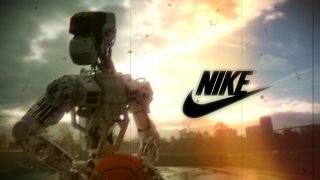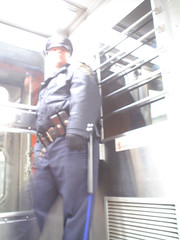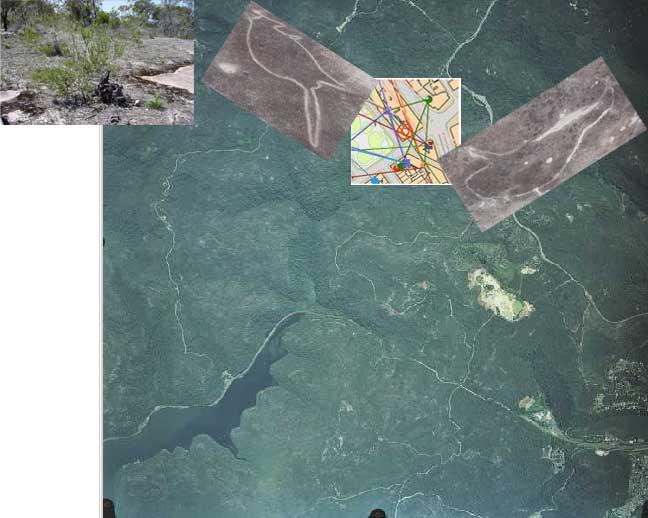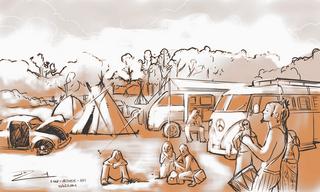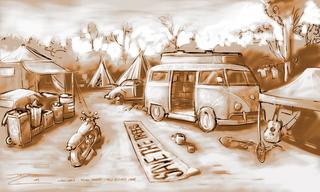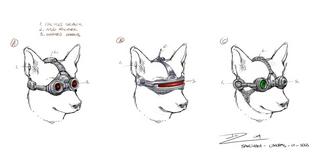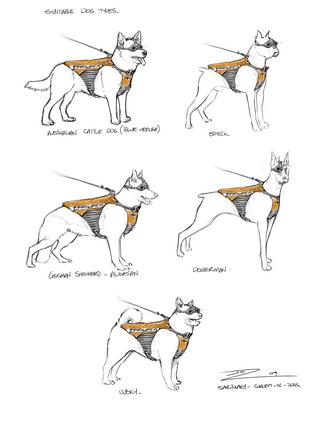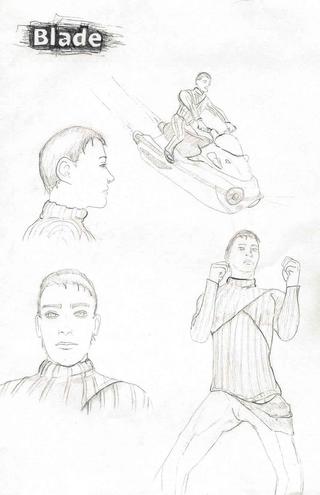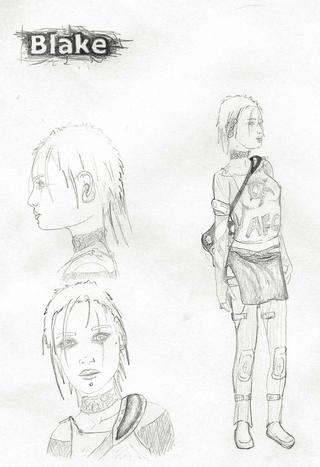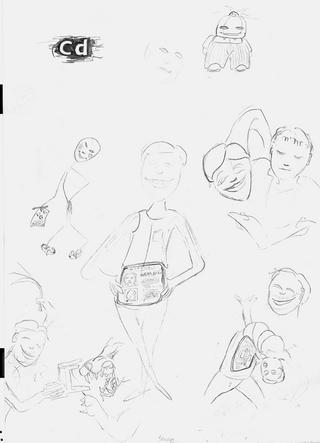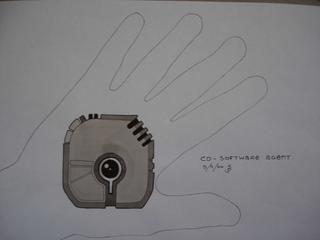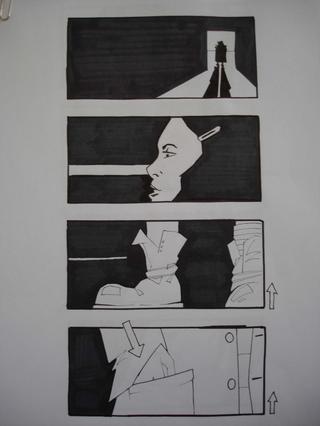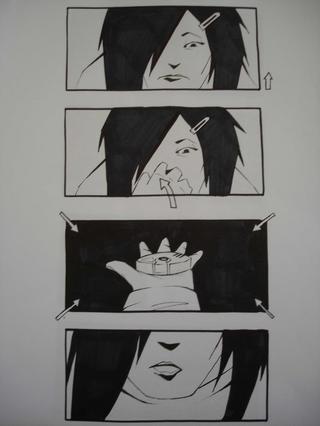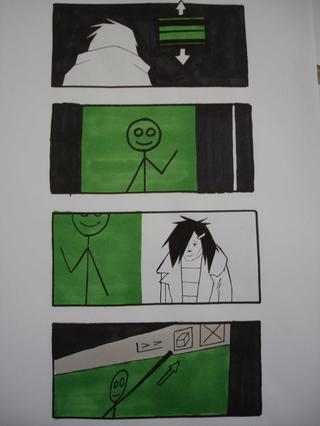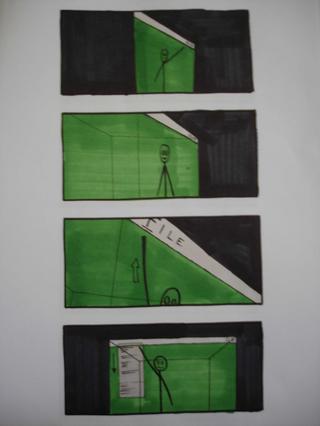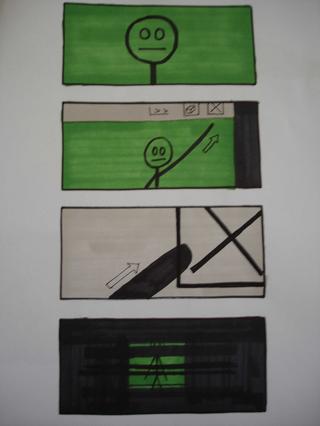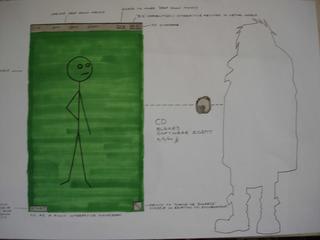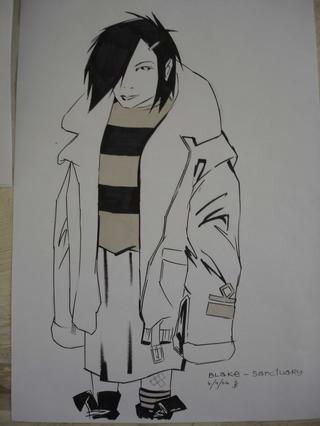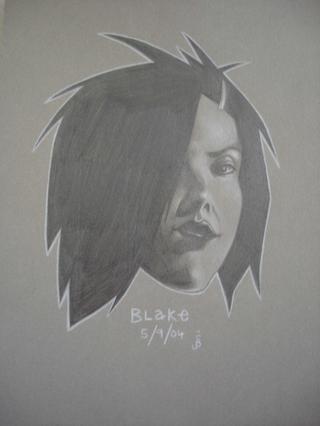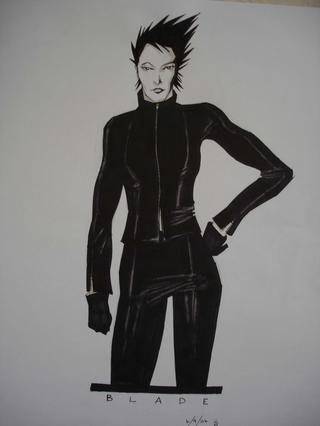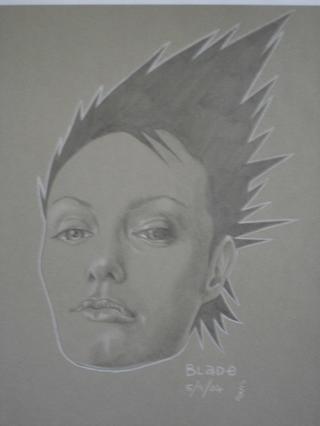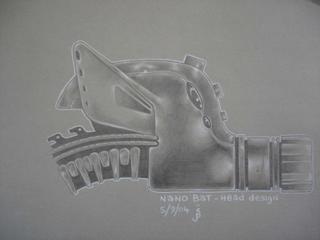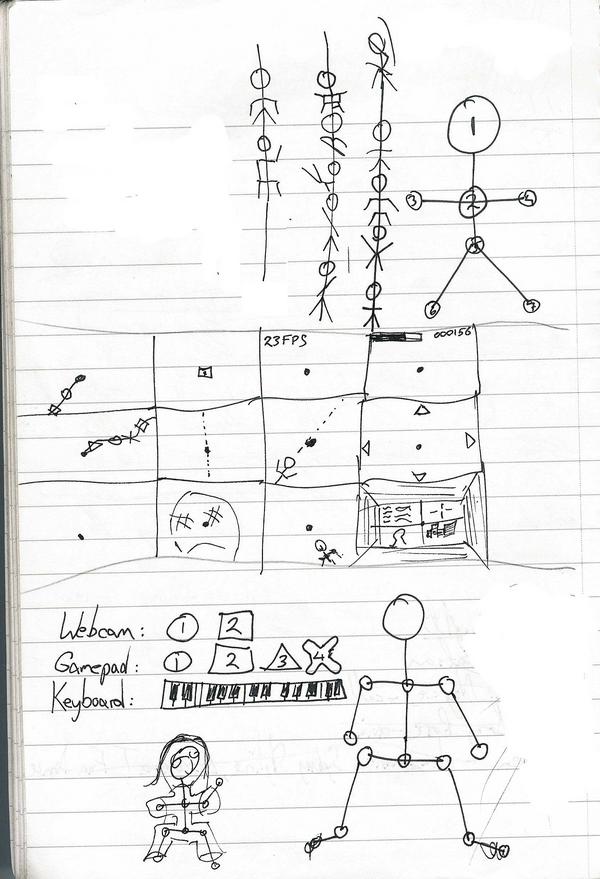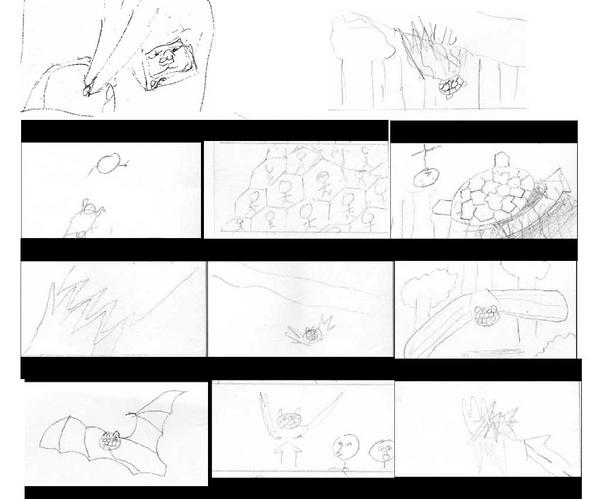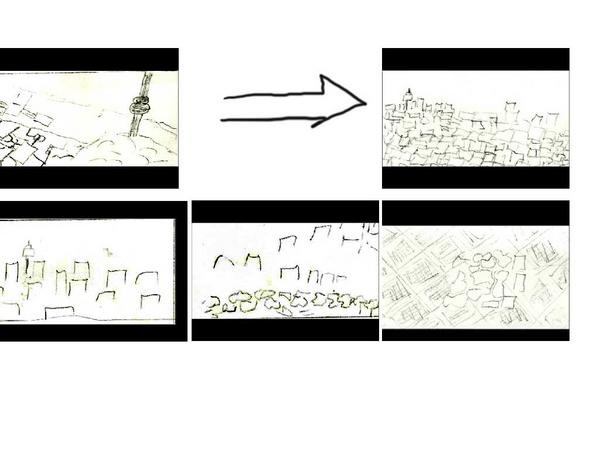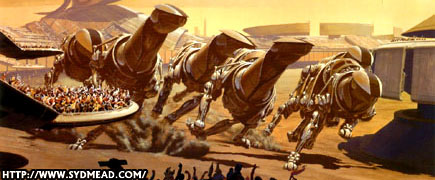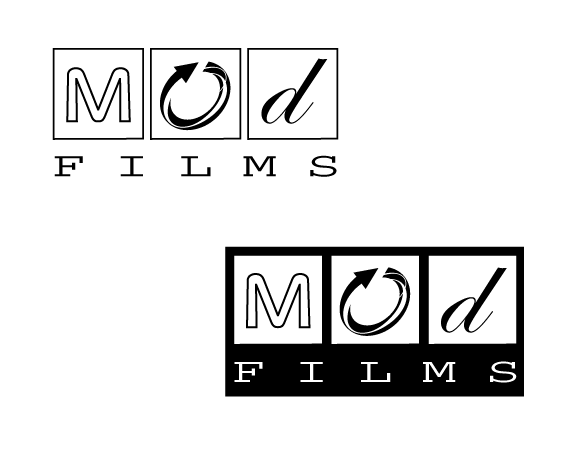November 13, 2007
Dirtified aesthetic/animation
I like the rough and ready feel of these character animations, matching real world focus pulls and comp'ed in foreground elements to give the material more grit.
lost in space: lost press gangs pacciani
April 03, 2006
Analogue visuals idea
Inspired by analogue FX in Depeche Mode's live set which I saw last night. The raw reporting style of CCD footage which works well has achieved via a lipstick cam recording of viewfinders of cameras covering the event.
Need more smart low tech low fuss solutions for finishing this flick! Kinda sick of hearing how much work is required to create a "quick and dirty sci-fi aesthetic"....
November 04, 2005
Storyboards
We never commissioned the final round of storyboards but this is the set that was used for the shoot.
or
June 30, 2005
Comic updated
| headbin gallery :: 20050630 comic
I've updated my comic with stills from the shoot. | 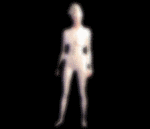 |
June 27, 2005
Postcard from the edit suite
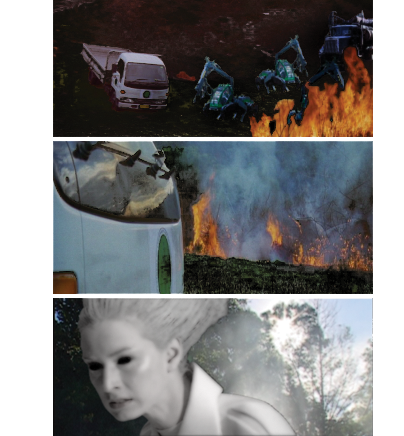
We almost have a rough cut. Not having the VFX side of the project locked in at this stage is proving a headache. I spent all of last week creating placeholder effects for the edit without which there are too many gaps in the narrative for it to make sense. We start showing the cut to people this week.
* Getting modelling and animation underway
* Finalising the copy for infographics
* Getting the story straight
* Finding the best bg plates for compositing, most options are DV
* Should Blake have shark eyes or not? Is she too hard to emphasise with like that?
April 05, 2005
Mapping the urban sprawl
Who needs VFX when you've got maps.google.com?
February 14, 2005
Dude, it's the cops
Checkout "Dude, look out, it's the cops" slide show of cops world-wide on Flickr.January 25, 2005
Blake's classroom finger
Scrolling up-wards from the bottom of the teacher's presentation, behind his back, an ASCII retro styling in response to classmate's jibe..._____ || || |\___/| | | | | | | | | | | | | _____|<--->|_____ / | | \ / | | | | \ | | | | | | | | | | | | | | | | | | | / | / \ / \ / | | | |

January 19, 2005
BAXTER 2005 Convergence for Human Rights
Thanks to Mish for digging up an old Vertigo (UTS student mag).
Who needs fiction? Check out what real activists have planned for while we shoot Sanctuary. EASTER WEEKEND March 25-28 2005. Facing up to troopers.
http://perth.indymedia.org/?action=newswire&parentview=8082
Would be great if we could arrange some footage swaps of troopers. Nice blue desert sky as blue screen?
Some pics of this lot in action outside the Baxter desert detention camp with riot police up in the State Trooper image gallery.
http://thequality.com/flics/10weeks/gallery/album18
December 14, 2004
DENR Control Room brief
The DENR control room is your classic security control room monitoring CCT cameras. The Department of the Environment and Network Resources are monitoring activities from all around the State. The bush is under surveillance by camera placed in the Sanctuary and surrounding urban sprawl. The cameras are triggered by motion sensors so there is wildlife captured as well as human activity.
This location, full of screens, is used to re-enforce the story aspect that everything is recordable. The control room sees what happens in schools, in the streets, in the sky, in backyards...
The data being presented here in 2D is also available in other more sophisticated forms. Blake hacks that data and this is how she appears to be a virtual form of the bush.
The State Troopers, wearing personal RIGs, can webcast their camera signals back to this control space as well. We see a nanobat being examined from this perspective.
Think of the surveillance capabilities shown in The End of Violence (the NASA room) and Enemy of the State (the CIA room) and Aliens (the trooper personal readouts). I don't want something as simplistic, and neat, as in Congo.
December 13, 2004
Art Dept questions
Michela could you give a brief description of what the State registry files will look like?
Q) What is the story of the RIG?
For decades researchers had been trying to create the ultimate man-machine interface. From crude wet-ware experiments in the 80s and 90s, the technology has evolved to allow a person's mind to be connected to a computer network with any invasive physical contact. A sophisticated array of wireless sensors was eventually devised and, the year before our story begins, the device was released for public consumption.
Like broadband, the Web, the PC, the jet, the car, and the wheel before it, the RIG quickly became a tool of the State, endorsed as a new way of life and seized upon by the DENR as the ultimate two-way tool for surveillance. You know longer have to look at computers. They look at you.
The Chief of the DENR has taken prime credit for the RIG (a little like Al Gore who "invented the Internet") and is the source of the corrupting influence in the heart of the State bureaucracy. His personal use of the RIG is becoming an obsession. He is taking increasing pleasure in defining the rules of the world.
Q) Are there Surveillance state cameras everywhere? what are their limits?
Yes, cameras are everywhere. Everything in the State is recordable. The principle limit on the cameras is that they require power and therefore funding. In practice there is more surveillance data available to the State than they can use. The Registry is awash with clutter.
Q) Does everyone have a RIG?
No. Only early adoptors do. It's a little like the take-up of the Sony EyeToy a year ago. "Hardcore gamers and drug dealers" according to one source. The DENR and Activist geeks like Dad are early adoptors - Big Brother vs Little Brother.
Q) How and why does she have a RIG?
Blake has a RIG because her Dad gave her one. He is a professor of Information warfare, a reformed hacker and into his toys. He's taken pride in passing on his knowledge to his kid and gave her bleeding edge technology to play with. Over time this became a bit of a cop-out for real parenting, a little like giving her a bedroom TV instead of personal attention.
Q) Will blake's avatar look the same in the void as the other virtual/augmented reality locations
Yes.
Q) Will she look as she does in the real world. ie bedroom as the avatar? ie are avatar and blake exactly the same or differently dressed or more extremely different ie steps to BLADE. is she identical but to her live action self but treated somehow.. holographic.. whatever..
Blake's appearance in virtual worlds must be different but subtle. There is no reason why her features and body should not be exactly the same (the price of photorealism has gone down) but equally the audience must know at all times that she is not in the real world. How this is shown is largely a question of budget and imagination. She could be slightly opaque, slightly wireframe, slightly streamlined, whatever.
I had two ideas - one similar to the girl in the red dress in Schindlers list (i.e. constantly treated slightly different visually with make-up and post) and the other looking identical but with subtle visual glitches (e.g. one-off distortion of face, flickering facial expression).
Q) if so are the state troopers also treated in the same way or are they real any way or as they are in both virtual and real worlds how do we represent that?
Think of the Ringwraiths in Lord of the Rings, they exist in two worlds at the same time. There is no reason why their virtual world appearance has to be the same as Blake's as long as its clear that what we are seeing is not something that exists in "the real world".
The PointOfViewBreakdown suggests that we use information overlays plus glitches in a stylistically different way from Blake. If we can show a person "degrading" momentarily to wireframe that would be nice but it would have to be used sparingly. That was one thing I wanted Xian to discuss with Artemis-style folk about.
November 02, 2004
Artistic direction for cinema
The key approach to Sanctuary is minimalistic storytelling. This is sci-fi where the details of the technology can be ignored. We are trying to communicate to two diverse groups. One that loves character driven narrative. One that loves a high concept idea.
Successful examples of mixing the two, in this genre, include La Jetée (1962) and Blade Runner (1982). Unsuccessful examples include Hackers (1995) and Matrix Reloaded (2003).
This is a re-mixable graphic novel with live action sequences
The simpler the overall construction of the film is, the easier it will be for the audience to rip it apart in the interactive version. There is a narrative context for static imagery and interrupted frame-rates. This is what I call the “dodgy systems” aesthetic oppoortunity (and "get out of jail free" card when thinking about budget concerns).
The bush action sequences must stand out in sharp contrast in terms of colour and movement.
We're juggling the telling of a good yarn with the introduction of a new paradigm and the ability to engage with it (through MODs). The telling has to be straightforward for the rest to work.
The devices I'd like to explore are:
- Use of static and strobing images
- 360 degree panaroma integration
- CG character integration
- Virtual set overlay on physical set
- GUI overlay on footage
- VR aesthetic using physical props and make-up
October 26, 2004
GIS in classroom presentation
The classroom presentation is a device for the State to show its relationship to the natural world and the pre-existing order of things in a good light. A cross between Shell and Guns Ltd. http://www.shell.com/ http://www.gunns.com.au/
One opportunity to quickly establish the theme of networking is to move between Aboriginal rock carvings in the sanctuary and futuristic GIS (Geographic Information Systems). Integrating this in with the establishment shots of the bush, State and city could be very interesting. The sophistication of Aboriginal carvings (e.g. how the animal shapes reflect the relative positioning of key landmarks like waterholes and other carvings) is new information to most people and a good hook.
Carvings are from the Calga Springs sanctuary outside Gosford.
The GIS display is part of a UK prototype "post-it" service - Urban Tapestries http://www.proboscis.org.uk/urbantapestries/prototype.html
Aerial photography from http://www.lpi.nsw.gov.au/airview/
MORE RESEARCH
======================================
petroglyph
petro = rock glyph =carving
The meanings of most of these petroglyph designs remain unknown.
http://www.hausarbeiten.de/faecher/hausarbeit/eni/16622.html
In Europe and Africa the style was largely naturalistic, while in Australia and the Americas designs were more often symbolic and geometric, and sometimes approached a primitive form of writing.
http://www.encyclopedia.com/html/r1/rockcarv.asp
D. S. Davidson, Aboriginal Australian and Tasmanian Rock Carvings and Paintings (1936)
http://www.viewzone.com/tablerock.html
Hypothesis of a global ancient alphabet in Aus and elsewhere
http://www.adelaidegrid.warp0.com/photo3.html
Whitley was the first American archeologist to do a dissertation interpreting rock carvings (the technical term is petroglyphs; rock paintings are pictographs). There has been a tendency among archeologists to regard the study of ritual and belief as less scientific and less relevant than the study of technology and subsistence. "It’s that bumper sticker: ‘He who dies with the most toys wins,’" Whitley says. "Which is, to me, a very shallow, materialistic view of human culture."
To illustrate his point, Whitley gives the example of Australian Aborigines. "You can take a line from the center of Australia out to the coast, and you can plot on that line a series of different aboriginal cultures. And if you look at the complexity of their kinship system and the complexity of their technology and tools, what you see is a perfect inverse relationship." Coastal groups have a complex technology and tend to use a lot of tools. In the middle of Australia, it’s more like it is in the Cosos. "Those guys are running around near to buck naked, surviving only on their wits, yet they have this kinship system that is mind-bogglingly complex. And it structures every aspect of their social life.
http://www.mc.maricopa.edu/dept/d10/asb/anthro2003/readings/altered_states.html
Now what is more important, this complex cognitive mental construct or the kind of tools these folks made?"
Ogleby, Clifford L., Digital Technology in the Documentation of Rock Art, 2nd AURA Congress, Cairns, Australia,
September, 1992.
Clear pictures - maybe fake...
http://artshack.tripod.com/aboriginalrockart.html
Australian Rock Art Research Association, Inc.
http://mc2.vicnet.net.au/home/aura/web/index.html
State Agency support
No databases are utilized regularly, although some projects in Australia have incorporated GIS into regions that include rock art sites. At least two state agencies in Australia, the News South Wales National Parks and Wildlife Services and the Australian Institute for Aboriginal and Torres Island Studies, sporadically use a database called 'Minarch'
13. Linking places: Constructing an Aboriginal social landscape using Arcview
Claudia Zipfel (Runner up Aus Archaeological Assoc. Conference Poster Prize
School of Historical and European Studies, La Trobe University (czipfel@students.latrobe.edu.au)
Based on a 2002 Honours research project this poster details the methodology developed for the construction of social landscapes in the GIS program ArcView. The project aimed firstly at constructing the context of the relationship between an Aboriginal community in the Wimmera and Mallee regions of Victoria and the archaeological remains found in its area today. Secondly, it examined the suitability of ArcView to construct and represent this context, ie. the social landscapes....
ArcView was found to be very useful for social landscape representations. It enables a visual and textual exploration of the interconnectedness of places, paths and inhabitants in space and through time. GIS seem particularly well suited for such a purpose as they have the potential to raise an awareness of the different and shared nature of social landscapes of archaeologists, Aboriginal and non-Aboriginal communities.
http://car.anu.edu.au/AAA_poster_session.html
AURA
P.O. Box 216
Caulfield South, Vic. 3162
Australia
auraweb@hotmail.com
Australian Archaeological Association Inc.
Archaeology A14
University of Sydney
NSW 2006
AUSTRALIA
Email:
mailbag@australianarchaeology.com
Telephone:
+61 (2) 9351 7412
Facsimile:
+61 (2) 9351 5712
Ausarch-l
http://mailman.anu.edu.au/mailman/listinfo/ausarch-l
October 22, 2004
Friendly fire virtual world
Damon's work on friend/foe recognition systems is one approach of how we can visualise the relationship between RIG devices without dwelling on physical devices in the real world.
Click on the following image to play video
Lower quality video | Higher quality video
Chiaroscuro
Simon introduced me to the concept of Chiaroscuro and the idea that real-time digital artists will one day move beyond bold contrasts in their work because the technology will support more variation.
I'd like to explore how we would shoot a bush location from a chiaroscuro-inspired lighting model (for virtual POV) and then shoot the same scene from a lighting model inspired by Australian Impressionism (for real POV). If it were possible to move between the two styles using real-time visual effects processing, that would be ideal.
chiaroscuro - A word borrowed from Italian ("light and shade" or "dark") referring to the modeling of volume by depicting light and shade by contrasting them boldly.
October 11, 2004
State dogs
Nothing like a remote-controlled rat to give you inspiration for a dog modified by the State.
By implanting electrodes in rats' brains, scientists have created remote-controlled rodents they can command to turn left or right, climb trees and navigate piles of rubble. Someday, scientists said, rats carrying tiny video cameras might search for disaster survivors.
http://www.wired.com/news/technology/0,1282,52236,00.html
Military nanobats
A Small Rolling Spy for the Marines
http://abcnews.go.com/Technology/CuttingEdge/story?id=97990&page=1
Mobile robot designs from the US
http://thequality.com/flics/10weeks/gallery/Robot-parts/nanospike
http://thequality.com/flics/10weeks/gallery/Robot-parts/nanoslug
http://thequality.com/flics/10weeks/gallery/Robot-parts/packbot
October 07, 2004
DENR Logo
From the Sanctuary script:
...'the logo for the State Department of Environment and Network Resources (DENR), a tree sprouting roots blending into circuitry.'
Concept Art Work in Progress
There is now a spreadsheet tracking the progress of the concept elements on the Wiki. It will be periodically updated from the master spreadsheet on Blade, so please don't panic if you find it a week or so out of touch.
http://modfilms.com/twiki/bin/view/Sanctuary/ConceptElements
October 06, 2004
Augmented Reality
More links to how the virtual world technology in the story is evolving.
Howstuffworks "How Augmented Reality Will Work"
http://www.headmap.org/ - location aware devices
IKEA scene in Fight Club
http://www.newhorizons.org/strategies/technology/shelton.htm - AUgmented Reality experiments in classroom
September 26, 2004
Nano bat Heat-Detecting Sensor
Heat-Detecting Sensor May be Able to Detect Lying
By Bijal P. Trivedi
National Geographic Today
January 2, 2002
As if taking off your shoes at the airport and having them electronically sniffed for explosives was not strange enough, future security devices could include heat sensors that would scan crowds for individuals thinking about committing, or having committed, some sort of deceptive act.
http://news.nationalgeographic.com/news/2002/01/0102_020102TVsensor.html
A new sensor has been developed based on the finding that lying or other acts of deception tend to cause excessive blood-flow to the face that can be detected with thermal imaging equipment. According to a new report published in the January 3 issue of the journal Nature, lying triggers a rush of blood around the eyes that can be detected by the heat sensor.
The expectation is that such technology might ultimately be used to pluck out terrorists or other criminals from crowds.
The researchers, led by James Levine, of the Mayo Clinic in Rochester, Minnesota, tested the heat-sensing lie detector by having some test subjects commit a mock crime—in this case stabbing a mannequin and taking its money. The subjects were then asked if they stole U.S. $20.
Levine found that the imaging device correctly pegged 83 percent of the study subjects as either innocent or guilty.
"If after more testing the technology proves accurate it could prove invaluable in high-level security operations, such as airport security, border checkpoints, schools, and federal buildings," said Levine.
Levine began working on the heat-sensing lie detector quite serendipitously.
Levine's research at the Mayo Clinic focuses on how subtle activities alter a person's metabolism. One such activity that piqued his interest was gum-chewing.
A few years ago Levine found that gum-chewing increased metabolism by 20 percent. To determine which muscles where involved in this task he had volunteers chew gum in the dark next to a thermal-imaging camera. One day during these dark gum-chewing sessions a metal plate fell in the room creating a loud crash.
The startling noise caused the panicked gum-chewer's face to glow on the thermal-imaging camera as blood rushed to her face.
This was the "Eureka moment," said Levine. "We wondered whether anxious behavior always caused blood to rush to this area around the eyes and wondered whether a thermal-imaging camera could be used as a lie detector."
The thermal-imaging technology is about as accurate as a polygraph lie detector, which measures pulse, blood pressure, breathing, and sweatiness. But the difference is that only when an expert administers the polygraph is accuracy more than 80 percent, said Levine.
The advantage of the thermal-imaging technology is that it does not require an expert to analyze the results. And it is non-invasive. It can take heat measurements without having to strap a person to a slew of sensors.
However, the imaging technology needs considerably more testing before it could be considered as a tool for security purposes, said Levine.
How eating or running would affect metabolism and the blood-flow to the face is not known, said Levine. The effects of psychological baggage would also need to be assessed. For example, would a person's guilt over a shoplifting incident affect the response if asked whether he or she was carrying a weapon while passing through a security checkpoint?
Levine believes the trick with the thermal imaging sensor is that it can record an instantaneous metabolic response to a question that is unaffected by other past events. Still, this needs to be tested.
The technology could also be easily abused. "Should the police have such a device in their car, for example," said Levine.
On the other hand, it would prove a wonderful new tool for journalists.
September 21, 2004
headbin image gallery
Thanks to Lewis for installing the new beaut Gallery system.
http://thequality.com/flics/10weeks/gallery/
We'll be tweaking a bit as we go and ironing out a few probs but you can now comment on individual images as requested. We'll be migrating the existing concept art threads across asap.
Any problems, let me know. We've still got some issues to sort out re. username/password setups but the same login details should work there.
September 20, 2004
Concept art - Jeremy Love
Temporary post for comments while the gallery system is being set up.
20040920
images/concept_art/jeremy_love
2)
3)
4)
September 15, 2004
Concept art - Brian Walker
Temporary post for comments while the gallery system is being set up.
Sketches from 2002 on early draft of ten weeks in the head bin
images/concept_art/brian_walker
Blade as male avatar
Blake
CD

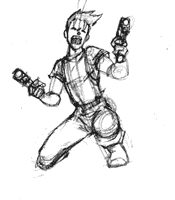
CD cloning Blade's movement
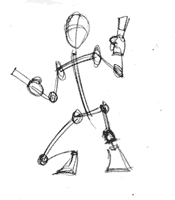
Must check if this Brian's or a drawing we found online - my favourite
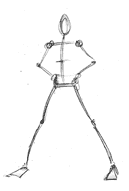
Concept art - Simon Duric
Temporary post for comments while the gallery system is being set up.
20040903
images/concept_art/simon_duric
1)
2)
3)
4)
5)
6)
7)
8)
9)
10)
11)
12)
Concept art - Basil Kinghorn
Temporary post for comments while the gallery system is being set up.
20040907
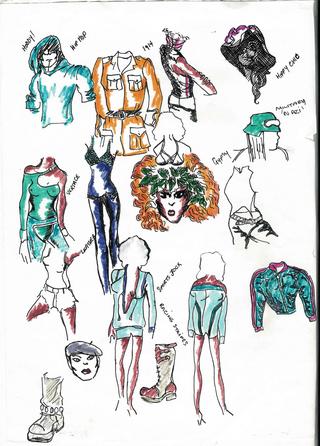 |
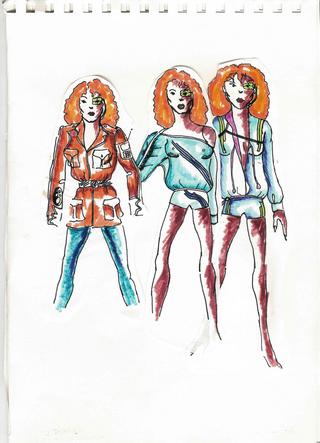
|
September 14, 2004
Concept art update / comic
* We're starting to receive concept art and we're going to get an online image gallery up and running to handle things smoothly. Anyone had any good/bad experiences with Gallery?
* We talking to quite a few concept artists about doing preliminary sketches prior to coming onboard the headbin. Please welcome Baz and Simon who're in first.
* I've been working on my own crude sketches as well to flesh out what I've been thinking of in terms of the overall look and feel and how the story could work in a comic form. I'm not planning on giving up the day job but it's been a helpful exercise. I'm gently prompting by all the prospective producers to clarify how this will look.
I'd like to focus the VFX discussion on the following 18 key panels. At least until we've had a chance to get more concept art in and move onto storyboarding with some of the elements better locked down and better drawn.
My breakdown notes on each panel - exported from Excel so refer to bottom left tags
(read comic zig-zagging down each page)
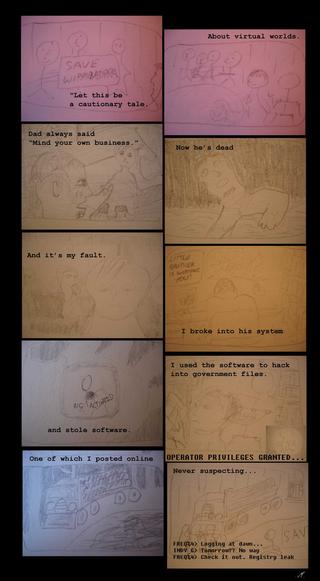
| 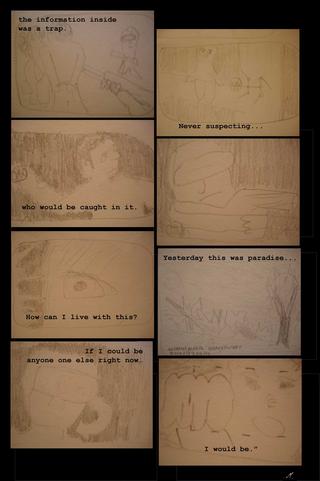
|
August 27, 2004
Risk of visual clash
The style of camerawork, lighting design and GUI overlays currently being considered lend the film an almost archival quality. The images will feel very immediate, very real, as if found in some dusty vault a hundred years from now.
This means that the barrier between spectators and spectacle will be very shallow. They will pick up on anything within the story universe that doesn't ring absolutely, 100% true.
Therefore the production design, in particular any future technology (e.g. the RIG, nanobats, wearable screens, etc.), will have to be very carefully realised to avoid raising any questions from the audience. They will have to believe that not only might things be designed this way in the future, but that they couldn't, in fact, have been designed any other way.
August 18, 2004
3D data visualization
http://hydra3d.sourceforge.net/indexFrames.html
http://graphics.stanford.edu/~munzner/h3/
http://www.caida.org/tools/visualization/walrus/
http://www.touchgraph.com/index.html
Concept Art Elements
These are the script elements requiring concept art.
Note: the State government department aesthetic needs to be offset against the eco-activist look
SETS
*State Registry (virtual warehouse)
*Blake's bedroom
*Aerial View of sanctuary and the urban sprawl
*DENR recording room
*Bush landscape - burning wreckage of heavy logging equipment
*Eco-activist HQ scene 'beat up vans, bikes'
CHARACTERS
*CD - Blake's software agent, permutations of
*Blake
*Blade - Blake's avatar (new super-hero)
*State Dog and Visor
*State Trooper
PROPS
*DENR logo
*Nanobat (schematic mechanism - open and closed)
*File (virtual), component of State Registry
*State surveillance camera
*Logging Truck
*Wearable Interface (Costume Designer?)
*Trooper Transport Vehicle
*Trooper's Rifle
*Activist flexi-screen in clothing
August 17, 2004
GUI aesthetic in Sanctuary
SPACE
Our hero (Blake) is a hacker, able to move freely between different computer systems, represented by different GUIs. The aim is to enable a passive non-technical audience to understand Blake�s power over virtual worlds, and any constraints, in a realistic manner. This constitutes the film�s �hacker� aesthetic.
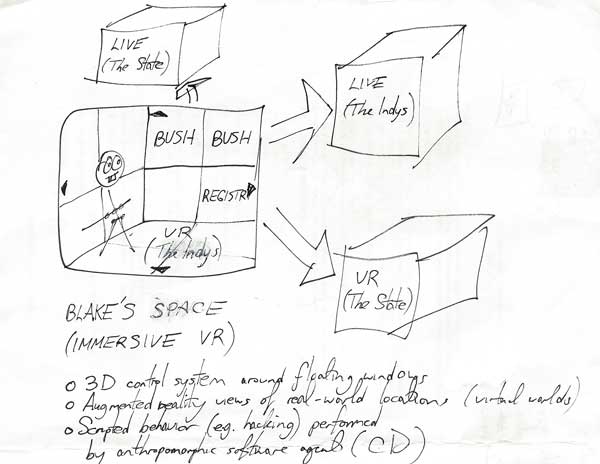
The story is set in the �near future� after the point where there has been a fundamental step in the evolution of the man-machine interface. A non-invasive technology called The RIG can be used to plug into the mental processes of any willing user and use this data to render an �augmented reality� point of view (POV). This POV can be of a wholly virtual world (e.g. the State Registry) or a view of the real world (e.g. the bush) as recorded by surveillance hardware. Surveillance is all-pervasive. Smart networks monitor the world.
In the story, the RIG is as common as the Eye-Toy is in 2004, a paradigm seeping into mainstream awareness as early-adopters use and abuse it.
The characters in the story do not distinguish between real-world footage (surveillance cameras), virtual world visualisation (photo-realistic data rendering) and recorded brain activity (character POVs). The key suspension of belief has to be that technology has advanced to the point that context is the only way to determine what is real. Any data source can be made to look the same. Hence the term the State uses to collectively refer to all its recorded data � �virtual memory�.
Sanctuary makes little reference to how the virtual worlds operate. The focus is on watching Blake rather than understand what she�s doing. The notion that everything has been recorded by the system is only revealed in the credits, a pay-off and incentive to re-run and play.
The degree to which the RIG can be used depends primarily on what OPS (Operator Privileges) are available. For example, the State�s surveillance system within the sanctuary is only supposed to be available to privileged State personnel. Blake�s power is that she can steal OPS.
TIME
The film leads the audience through the story in �real-time�, witnessing how Blake becomes Blade as events actually unfold.
The film�s payoff is that anything is record-able. All the events witnessed have been captured within the State�s �virtual memory�, setting up the premise for the wider story universe explored in ten weeks in the head bin.
"Anything is record-able" is a fundamental rule of this world. Any POV shown in the film, in the context of the narrative, can be replayed by accessing a system with the right level of OPS. It is no coincidence that the whole film functions as a loop.
Blade�s origin story is preserved for subsequent review by characters themselves as well as the audience. The film functions as a time-capsule and seeds the idea that there are other characters sifting through �virtual memory� along with the audience.
GUI
Big Brother meets Little Brother

The story-telling involves the use of three visually distinct GUIs. The use of these GUIs is a device for depicting visually, to the film audience, what kind of OPS are available. Each GUI places restrictions on what can or can�t be done by the user.
- The State interface � run by the Department of the Environment and Network Resources, the standard government interface across all public and secret government services. Think futuristic 3D, corporate styling.
- The Activists' interface � run by eco-activists who monitor the State. Think minimalist 2D, purely functional (e.g. old school Linux) styling.
- The �Customised Dude� interface � run by Blake, a personal interface to virtual worlds, hacked from illegal software swiped from her father�s home office. Think crude but highly flexible stick figure plastered onto top of (or embedded within) other systems.
The challenge will be to cleanly depict each of these GUIs in the narrative whilst creating opportunities for the audience to mimic Blake�s GUI-hopping behaviour in the real-time environment on DVD. The rhythm game (Groover) is all about letting the audience play wth CD and thus experience what is like to interact with the story through Blake's personal interface.
The virtual worlds of the story can appear identical to the real world (e.g. the bush). The audience is alerted to a virtual POV through CG elements that come and go either as match-moved 3D elements or as 2D overlays. The distinction between REAL-WORLD and VIRTUAL WORLD in the script can be made primarily through glitches in the virtual worlds.
CD as interface - xeyes
The old UNIX app, XEyes, is the original hook for CD to form part of the user interface.
Flash implementation:
http://www.figleaf.com/development/flash5/eyes.swf
Stereo Photogrammetry
Nick Doff from Artemis Digital has supplied a video showing their new live action/mocap service in action. They've already offered to do up to 2mins of mocap on CD for free so maybe deal possibilities.
Download video (MPEG1)
August 09, 2004
Battlestar Galactica
Dale Herigstad of Schematic gave me a sneak preview last night of the look and design background to the XBox2 prototype he is building for the XBox2 edition of the Battlestar Galactica TV series. Smooth segues from TV to shoot 'em up to network promo to EPG (electronic programme guide). The defacto standard 3D interface seems to come from him (e.g. TimeWarner interactive TV trials in Orlando, Minority Report, X Files, XBox 2....)
"reality space" aesthetic. CGI warfare scenes feel like hometown aerial shows shot by handheld camera, with abrupt zooms, unexpected pans and streaming contrails.
http://www.wired.com/news/games/0,2101,61436,00.html
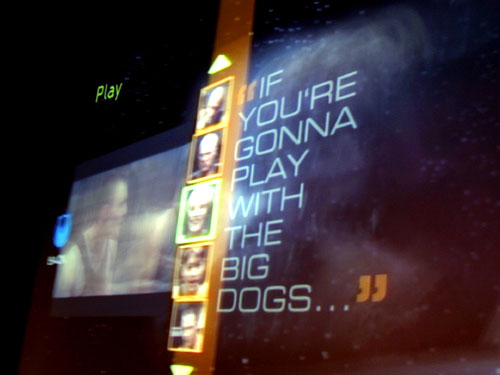
June 24, 2004
Ty Ruben
Ty Ruben and I had a good chat about concept art. He has been a specialist in mechanical concepts since leaving Lucasfilm in 1995. I'm thinking of him as focusing on the eco-activist aesthetic and the nanobats.
He recommended The Embassy Visual Effects Inc. as a company to contact re. the project.
June 23, 2004
The two towers
Centrepoint Tower - Sydney (on left) and Black Mountain Tower - Canberra (on right).
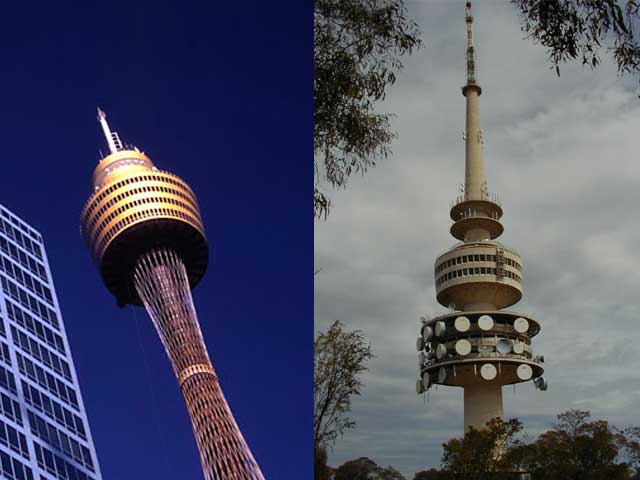
Here’s a test clip I made of Centrepoint earlier this year.
Sydney Skyline time-lapse movie
Been talking to Yogi at Central Pictures about the feasibility of procedurally generating the urban sprawl in between the two towershttp://www.centralpictures.com/ce/index.html
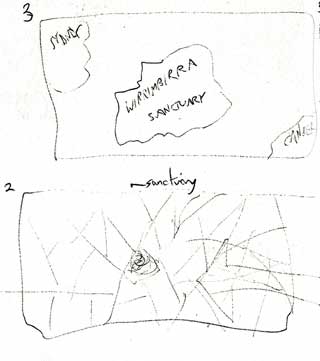
Flexible screens
EE Times -Philips unit unveils 'rollable' displays
Suzanne Lee (suzanne.lee@virgin.net), fashion technology expert:
No-one yet is making a fabric screen. Flexible displays are being explored these are mostly on plastic substrates.
Time-lapse bush
It is important that the virtual world and the real world sequences are distinguishable from each other. One idea I've had for this is to use a time-lapse sequence when first introducing the bush as Blak experiences it. It might be cool to see natural growth of the sanctuary (a couple of month's worth of time-lapse) as a form of non-linear access to the surveillance network Blake hacks.
There is a similar metaphor in 10weeks - Cityscape re-configures itself.
June 21, 2004
Syd Mead dog things
Syd Mead did concept art for Tron, Blade Runner, Aliens and here's a nice little dog-thing picture. I saw them as streamlined in the flesh but crawling with nasty code underneath so when you see them as CD sees them they look quite horrible. This is how people would see them more.
June 10, 2004
NASA nano-bats
Metallic balls that float around after astronauts in space.
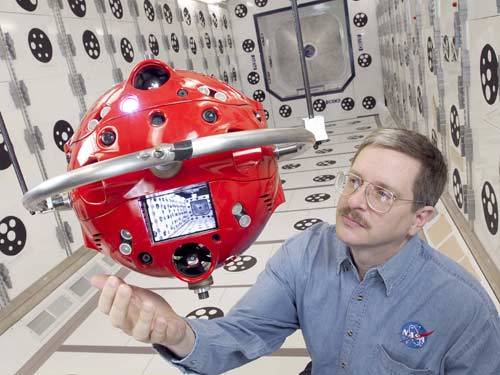
Wired News: A Jet-Powered PDA for Astronauts
Concept Artists Forum
Might be a good place to start looking for concept artists.
May 26, 2004
Concept art for Matrix sequels
CGNetworks - Concept Art Production for The Matrix Reloaded/Revolutions looks at the concept design and graphic story telling approach used on those films.
May 14, 2004
Immersion Studios
I ran into Malcolm Garrett this week who is working at Immersion Studios in Toronto.
Interestingly enough, they do Immersion Classrooms, Simulations, Immersion Cinema and other forms of real-time film-making.
May 05, 2004
Universite tangente - A la Carte
Excellently dystopian political maps produced by universite tangente (the tangential university). Who needs fiction?
Map of the prison-industrial complex (2002)
Map of infowar/psychic war - marrying the mission to the market (2003)
Identification Systems / Surveillance and Databases Map (2002)
April 16, 2004
Half-Life2 E3 teaser
For a taste of what's coming in the next generation of games, you could do worse than check out this monster download of Half-Life 2, the most anticipated game in history.
Funny enough, the 'game-play' people are lining up for is simply the ability to fiddle around with the terrain and props in each scene. Shooting guns has been done before but not the ability to rip a world The imagery is driven by Valve Software's new Source engine, available for licensing, which knocks the socks off anything previously.
http://www.valvesoftware.com/sourcelicense/enginefeatures.htm
April 08, 2004
CD is the star of N
See a groovy stick figure in action in web game "N" by MetaNet Software.
http://theculturalgutter.com/videogames/the_power_of_n.html

April 06, 2004
Rubberbanding
One technique for getting across the nature of hacking in the script can be "rubberbanding". I'm seeing it a little like bungee jumping, except that what you're jumping into is the network technology surrounding a mind. If the hack fails, you get flung back out of the system rather violently.

April 01, 2004
Transport
A little inspiration for the trooper APC...?
http://batmanbegins.warnerbros.com/page.html
March 31, 2004
Bats
Regent's Park at dusk in summer is a great spot for bat action as the critters swoop low across the lake hunting insects.
March 18, 2004
Reference footage and other media
Influences and reference material for Sanctuary (e.g. pre-vis, collage)
FILMS
Whale Rider - young girl misfit hero, proud angry jaw
Ned Kelly - burning aussie bush aesthetic
The Matrix - fluid movement through virtual space/mental agility
Matrix Reloaded - dangerous atheletic female
Minority Report/Matrix Reloaded - body language user interface
Starship Troopers - humourous Web user interface (uber flash text)
Heathers - classroom hierarchy (Blake is geek)
Beetlejuice - outsider teenage girl bedroom
Horses for Courses - fluid movement through painterly forest
Tron - minimalistic virtual world
ET - silent watchers (State technicians)
Enemy of the State - surveillance overload
Strange Days - 1st person/VR/look in mirror
Ghost in the Shell - wet-ware, cyberorganic elements
Nausicaa - relationship between teenage girl and nature
Wizard of Oz - get out and back home
ET/Close Encounters/Poltergeist - Spielberg suburbia, just add Hills' Hoists
Hulk - creative use of panelling, wipes, and transitions
Eternal Sunshine of a spotless mind - erasing virtual elements of a scene
Dark Crystal - bat as surveillance devices
TV
24 - panelling, pace
COMMERCIALS
NIKE basketball commercial - stick figure a litte like CD
MUSIC VIDEO
Star Guitar by The Chemical Brothers - rythmic visuals
*see http://www.director-file.com/gondry/Dxliv.html# and follow "mov" link on right
Royksopp - Remind Me - diagrams/maps of complexity
GAMES
Gitaroo Man - rhythm game interface
Half-Life 2 - troopers streetfighting
Rez - low rez fly-through The System, hacking
VIDEO ART
HeadCleaner - industrial banging for action sequence
March 08, 2004
Julia Bardsley - Transgression
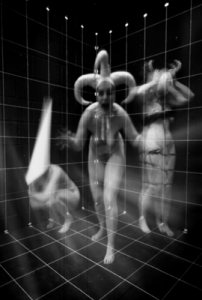
|
Julia Bardsley's a NESTA supported artist and this piece is the closest I've come across that captures the kind of aesthestic I'm envisaging for Blake's online (virtual) space. Think this but messier. What kid has time to tidy up their bedroom when they're out trying to save the world... (one of those annoying framesets so here's link to her homepage http://www.juliabardsley.net |
February 06, 2004
October 31, 2003
Visualisation of the re-mixable film structure
The relationship between film assets, used in the cinema version and the flic - the core product as NESTA wants to have clarified in the final pitch - the re-mixable film on DVD has to have a clean browsable map of all the available assets.
Here's a good example of what I think works. If you've got any thoughts, leave a Comment. Ideally what we use is a system that generates the map.
Here's one example.
The Visual Thesaurus, a Dictionary of the English Language
September 22, 2003
Dot and the Kangaroo
 | A big inspiration for this project is Dot and the Kangaroo made in 1977 and is still rated today as one of the best kids animated films. The mix of live film footage of the Australian bush and cartoon people and animals is the closest I've seen to what I'm envisaging for web3d/film integration. Made by Yoram Goss. |
Blake's bedroom
What does a girl like Blake have in her bedroom?
Sanctuary imagery via Google
SANCTUARY: alsation | pipistrelle bat | Wirrimbirra | Tawny Frogmouth | Spiderman | mugshots | australian bush | kookaburra | network control room | molecules | eye | webcam | circuitry | silcon chip | blue tongue lizard | Bearded dragon
